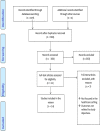Factors contributing to the patient safety culture in Saudi Arabia: a systematic review
- PMID: 33055115
- PMCID: PMC7559108
- DOI: 10.1136/bmjopen-2020-037875
Factors contributing to the patient safety culture in Saudi Arabia: a systematic review
Abstract
Background: Patient safety, concerned with the prevention of harm to patients, has become a fundamental component of the global healthcare system. The evidence regarding the status of the patient safety culture in Arab countries in general shows that it is at a suboptimal level due to a punitive approach to errors and deficits in the openness of communications.
Objectives: To identify factors contributing to the patient safety culture in Saudi Arabia.
Design: Systematic review.
Methods: A systematic search was carried out in May 2018 in five electronic databases and updated in July 2020-MEDLINE, CINAHL, Embase, PsycINFO and the Cochrane Database of Systematic Reviews. Relevant journals and reference lists of included studies were also hand-searched. Two independent reviewers verified that the studies met the inclusion criteria, assessed the quality of studies and extracted their relevant characteristics. The Yorkshire Contributory Factors Framework (YCFF) was used to categorise factors affecting safety culture in the included papers.
Results: 14 papers were included and the majority of studies were appraised as being of good quality. Strength and weakness factors that contribute to patient safety culture were identified. Ineffective leadership, a blame culture, workload/inadequate staffing and poor communication are reported as the main factors hindering a positive patient safety culture in Saudi Arabia. Conversely, 'strength' factors contributing to a positive patient safety culture included supportive organisational attitudes to learning/continuous improvement, good teamwork within units and support from hospital management for patient safety. There is an absence of patient perspectives regarding patient safety culture in Saudi Arabia.
Conclusion: Policymakers in the Saudi healthcare system should pay attention to the factors that may contribute to a positive patient safety culture, especially establishing a blame-free culture, improving communications and leadership capacity, learning from errors and involving patient perspectives in safety initiatives. Further research is required to understand in depth the barriers and facilitators to the implementation of a positive patient safety culture in Saudi Arabia.
Keywords: health & safety; quality in health care; risk management.
© Author(s) (or their employer(s)) 2020. Re-use permitted under CC BY-NC. No commercial re-use. See rights and permissions. Published by BMJ.
Conflict of interest statement
Competing interests: None declared.
Figures


References
-
- Health and Safety Commission Advisory Committee on the Safety of Nuclear Installations Organizing for safety: third report of the ACSNI study group on human factors Sudbury. HSE Books, 1993.
-
- Ulrich B, Kear T. Patient safety and patient safety culture: foundations of excellent health care delivery. Nephrol Nurs J 2014;41:447–59. - PubMed
-
- World Health Organization 10 facts on patient safety, 2018. Available: http://www.who.int/features/factfiles/patient_safety/en/
Publication types
MeSH terms
LinkOut - more resources
Full Text Sources
Medical
Research Materials
Miscellaneous
